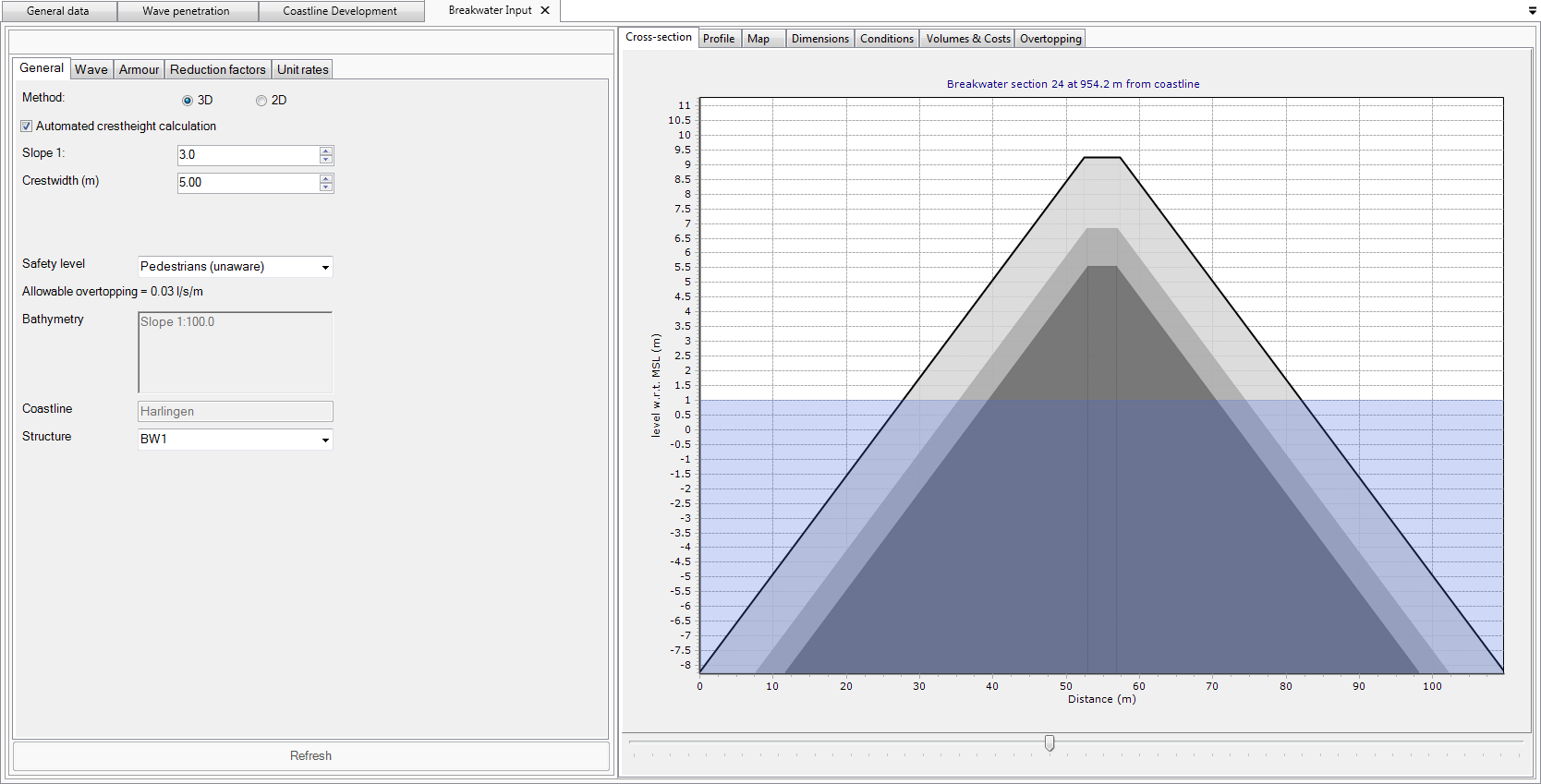
Coastal Design Support (CoDeS) tools are relatively simple software tools aimed to support engineers in the design of coastal engineering solutions and the communication towards clients and stakeholders. The tools provide quick insights in orders of magnitude of environmental conditions and impacts of human interventions. This way they help to arrive at promising solution directions during an early stage of a project. Bringing CoDeS tools together in one software environment enables engineers to use and improve the same knowledge base in order to increase the efficiency of projects and promote the integration between different disciplines. Moreover, an easy to use General User Interface (GUI) makes them accessible for a wide range of users (e.g. project engineers, managers, reviewers).
Following a successful JIP CoDeS Pilot, Royal HaskoningDHV, Witteveen+Bos and Deltares continued the Joint Industry Project (JIP) with CoDeS 1.0.

Figure 1: OVerview of the CoDeS tools framework in which tools from different disciplines related to the design of coastal engineering are brought together.
The objectives of JIP CoDeS 1.0, following the developments made within the JIP CoDeS Pilot, are defined as follows:
These objectives support the stimulation of demand driven R&D and knowledge dissemination through easy-to-use CoDeS tools.
A team of coastal engineers, programmers and managers (product owners) from the three JIP partners work together on tool development in sprint sessions following a SCRUM alike methodology, following the positive feedback on such methodology from the CoDeS pilot. Each sprint session has a clear scope and clear roles and responsibilities for the team. During the sprint sessions engineers and programmers use scripting (Iron Python and C#) to program CoDeS tools and link them to the Delta Shell user interface to make them easily accessible to the user community. In addition to the first (pilot) stage, a generic data module is added to the CoDeS framework, in order to support uniformity, integration and interactivity throughout the different CoDeS tools. Furthermore, first steps have been made to add tests to the CoDeS framework to validate the functioning of the tools and secure robustness when more tools are added to the framework in the future.
JIP CoDeS 1.0 is subdivided into three sets of sprint sessions. All these sprint sessions were concluded by a demo of the developed product to the advisory board (AB) for feedback and steering in priorities for subsequent developments. The scope of the sprint sessions was as follows:
Products
Compared to the JIP CoDeS pilot the CoDeS tools framework was extended with following tools and functionality (Figure 2, objective 1):
Apart from these be tools and extensions considerable has been put in making the framework more robust (by including a shared data model and tests) and improving the look & feel of the framework in terms of uniformity and accessibility for non-trained users. This has increased the use of the developed tools within the partners' organization considerable compared to the product of the JIP CoDeS Pilot. Moreover, the CoDeS community has become more mature in the sense that also internal and external contributions to the tools have been made outside the JIP project itself (objective 2 and 3). In order to demonstrate the use of the framework to a wider audience a showcase has been developed for the Scheveningen case. This indicative case study, illustrating the use of the tools in a real-life project, has been compiled in a conference paper which was presented at the PIANC Copdec 2016 conference in Rio de Janeiro, Brazil. The conference paper can be downloaded here (objective 4).
How do I get access to the product?
The embargo on the product was lifted in July 2017. The python code of the tools can be freely downloaded form the OpenEarth repository. You can sign up for OpenEarth on the Deltares open source website. To use the tools in conjunction with the GUI, you need to acquire Delta Shell. To this end, you can either purchase a service package of the Delft3D Flexible Mesh suite or apply for a free version of Delta Shell without support. To link the tools to the Delta Shell GUI please read the Read-Me document.
Working together in sprints using a SCRUM alike methodology was found to provide a very productive, constructive and pleasant working experience during both the CoDeS pilot and CoDeS 1.0 projects. Furthermore, the threshold for new developers to start-up and join the team is found to be fairly low (~couple of days). In order to streamline CoDeS software development in a professional manner, the software development tool JIRA was introduced in order to manage and structure the development process. Still the technical documentation and testing of the tools should be further professionalized to guarantee a robust framework that will stimulate the use in practice even further. This will most likely be part of the scope of a follow-up TKI project (CoDeS 2.0).
All partners are enthusiastic about the progress being made and product being delivered and wish to continue the cooperation. This led to the initiation of a follow-up TKI project: JIP CoDeS 2.0. The exact scope of this project is still under discussion, but it will most likely include a connection to global databases (e.g. for tides, waves, bathymetries and shorelines), improved data management and a stronger focus on interdisciplinarity by the inclusion of tools related to ecology. Other parties that are interested to use the tools or participate in future cooperation and development can contact Mr. Wiebe de Boer or Mr. Freek Scheel.




Figure 2: Overview of the CoDeS tools developed in JIP CoDeS 1.0: general data module (upper left), breakwater design module (upper right), coastline evolution (lower left) and flow fields in and around the port (lower right).